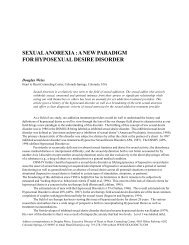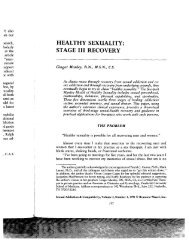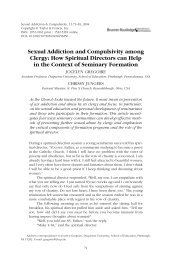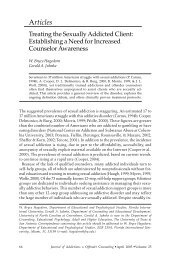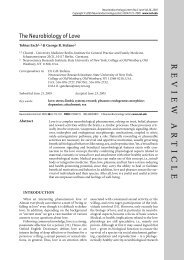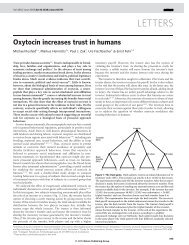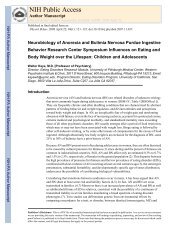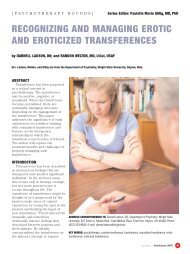An Overview of Psychiatric Ethics
An Overview of Psychiatric Ethics
An Overview of Psychiatric Ethics
You also want an ePaper? Increase the reach of your titles
YUMPU automatically turns print PDFs into web optimized ePapers that Google loves.
Psychiatry and Human Rights2Madness needed to be seen in the context <strong>of</strong> the social and psychological factors affecting thepatient. Based upon post-mortem examinations, Pinel argued that there were organic causes tomadness, found in the gastrointestinal and peripheral nervous systems. As neurosyphilis was acommon cause <strong>of</strong> madness in the late Eighteenth Century, the Enlightenment methods <strong>of</strong> tissueexamination and pathological science were highly applicable to psychiatry.Pinel engaged in ”moral treatments”, involving ‘therapeutic’ conversations with patients, seekingto encourage them to withdraw from their delusional ideas. He attempted reform <strong>of</strong> the culture<strong>of</strong> asylums, choosing to involve patients in the daily life <strong>of</strong> the asylum and choosing his asylumattendants carefully. Despite the celebrated rationality <strong>of</strong> Pinel’s methods, he still partook inexercises <strong>of</strong> coercive power and his patients had little choice other than to cooperate with treatment.Moreover, Pinel continued to employ physical treatments such as baths, showers, opium, camphorand laxatives.31Norton Manning – The ‘Down Under’ Pinel?Frederick Norton Manning became medical superintendent <strong>of</strong> the Tarban Creek Lunatic Asylum(Gladesville Hospital) on 15 October 1868. Manning became immediately concerned about theisolation <strong>of</strong> patients from the rest <strong>of</strong> the community and described the hospital as “prison-like andgloomy”. Patients had inadequate facilities, monotonous and non-nutritious diets and little to occupythem. Manning described Tarban Creek as a “cemetery for diseased intellects”, set about minimizingthe use <strong>of</strong> restraint and provided resources for patient activities.In July 1876, Manning was appointed Inspector <strong>of</strong> the Insane with responsibility for all mentalinstitutions, except the Parramatta asylum for criminals (now Cumberland Hospital). He wasappointed Inspector-General <strong>of</strong> the Insane in 1879 and introduced a series <strong>of</strong> reforms to addressthe problems at the Parramatta asylum. Manning sought to engage the community in the treatment<strong>of</strong> mental illness by encouraging visits to the asylums (not in the vain <strong>of</strong> the Bethlehem visits) as wellas organizing many public discussions about the care <strong>of</strong> the mentally ill. Manning made frequentvisits to the UK to keep in touch with the advances in psychiatry and was particularly impressedwith a psychiatric institution being constructed at Chatham in Kent. Manning obtained copies <strong>of</strong> theconstruction drawings and agitated for a similar facility to be built. New psychiatric hospitals werethen constructed along similar plans at Callan Park and Goulburn. Manning oversaw pr<strong>of</strong>essionaldevelopment programs for staff in the hospitals and argued successfully for improvement in workingconditions. Along with John Cade (who described the therapeutic properties <strong>of</strong> lithium) Manning isregarded as one <strong>of</strong> the most important figures in the history <strong>of</strong> Australian psychiatry.The Crimes <strong>of</strong> the Nazi PsychiatristsOriginsPrior to Hitler’s ascent to power, German psychiatry was enamoured <strong>of</strong> eugenics, the removal <strong>of</strong>“inferior genetic stock” from the population. In 1913 German psychiatrist Alfred Ploetz foundedthe German Society for Racial Hygiene. <strong>An</strong>other psychiatrist, Ernst Rüdin, became his enthusiasticacolyte. Declaring racial hygiene a “spiritual movement,” Rüdin and his disciples aimed to propagatethe cause.Racial hygiene derives from Charles Darwin’s ideas about evolution, and the superiority <strong>of</strong> certainforms <strong>of</strong> the same species. Conflated with the ideas <strong>of</strong> Nietzsche and German Romanticism, thisbecame the basis <strong>of</strong> Nazi racial theory, where Jews, Slavs and coloured people were inferior toAryans. Amongst the Aryans, the mentally deficient or physically weak were inferior to the AryanÜbermenschen (supermen). Hitler came to power in Germany in January 1933. On July 4, 1933 the“Sterilization Act” became law, followed ten days later by the “Law for the Prevention <strong>of</strong> GeneticallyDiseased Children”. Four hundred thousand people, thought genetically inferior, were sterilized onthe orders <strong>of</strong> a network <strong>of</strong> over two hundred “Genetic Health Courts”. By 1936, many psychiatricpatients were being transferred from asylums to Dachau and other concentration camps.Aktion (Operation) T4In October 1939 Hitler ordered the killing <strong>of</strong> patients, or “inmates”, <strong>of</strong> German psychiatrichospitals. Aktion T4 was aimed at eliminating children suffering from “idiocy”, Down’s syndrome,IMET AN OVERVIEW OF PSYCHIATRIC ETHICS



